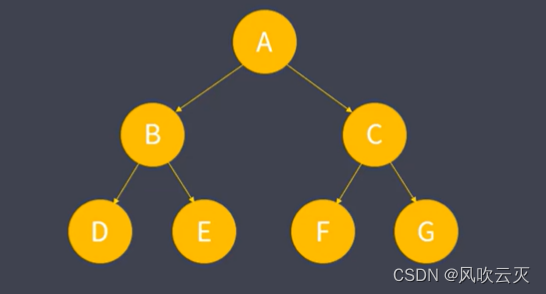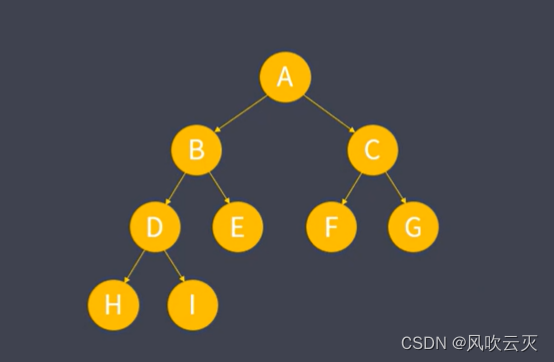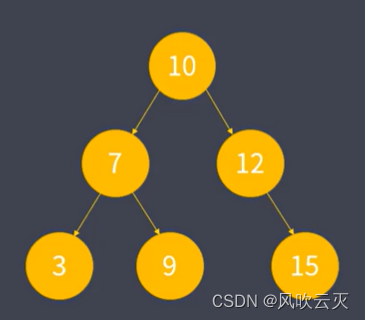栈
- 先进后出
- 栈顶操作(栈顶进,栈顶出)
class Strock {
constructor() {
this.data = [] // 可以是对象
this.count = 0
}
push(item) {
// 实现有三种
// 1. this.data.push(item);
// 2. this.data[this.data.length] = item; this.count++
// 3
this.data[this.count] = item
// 入栈后,count 自增
this.count++
}
pop() {
// 出栈的前提是栈中存在元素,应先行检测
if (this.isEmpty()) {
console.log('栈为空!')
return
}
// 移除栈顶数据
// 方式1:数组方法 pop 移除
// return this.data.pop()
// 方式2:计数方式
const temp = this.data[this.count - 1]
delete this.data[--this.count]
return temp
}
// isEmpty() 检测栈是否为空
isEmpty() {
return this.count === 0
}
top() {
if (this.isEmpty()) {
console.log('栈为空!')
return
}
return this.data[this.count - 1]
}
size() {
return this.count
}
cleatr() {
this.count = 0
this.data = []
}
}
含有min函数的栈
- 辅助栈实现
// 在存储数据的栈外,再新建一个栈,用于存储最小值
class MinStack {
constructor () {
// stackA 用于存储数据
this.stackA = []
this.countA = 0
// stackB 用于将数据降序存储(栈顶值为最小值)
this.stackB = []
this.countB = 0
}
// 入栈
push (item) {
// stackA 正常入栈
this.stackA[this.countA++] = item
// stackB 如果没有数据,直接入栈
// 如果 item 的值 <= stackB 的最小值,入栈
if (this.countB === 0 || item <= this.min()) {
this.stackB[this.countB++] = item
}
}
// 最小值函数
min () {
return this.stackB[this.countB - 1]
}
// 获取栈顶值
top () {
return this.stackA[this.countA - 1]
}
// 出栈
pop () {
// 先进行 stackB 的检测
// 如果 stackA 的栈顶值 === stackB 的栈顶值,stackB 出栈
if (this.top() === this.min()) {
delete this.stackB[--this.countB]
}
// stackA 出栈
delete this.stackA[--this.countA]
}
}
const m = new MinStack()
- Math.min方法实现
class MinStack {
constructor () {
this.stack = []
}
// 入栈
push (item) {
this.stack.push(item)
}
// 查看栈顶值
top () {
return this.stack[this.stack.length - 1]
}
// 实现最小值功能
min () {
return Math.min.apply(null, this.stack)
}
// 出栈方法
pop () {
return this.stack.pop()
}
}
const m = new MinStack()
每日温度
力扣题目 739. 每日温度
function s(arr) {
let data = [0] // data是一个逆序栈 (变-> 小) 存储入栈的下标
let count = 1
let returnArr = Array(arr.length).fill(0)
for (let index = 1; index < arr.length; index++) {
const element = arr[index];
while (count && element > arr[data[count - 1]]) {
let i = data.pop()
count--
returnArr[i] = index - i
}
data.push(index)
count++
}
return returnArr
}
console.log(s([73, 74, 75, 71, 69, 72, 76, 73])) // [1, 1, 4, 2, 1, 1, 0, 0]
队列
- 先进先出
- 队首出,队尾入
class Queue {
constructor () {
// 用于存储队列数据
this.queue = []
this.count = 0
}
// 入队方法
enQueue (item) {
this.queue[this.count++] = item
}
// 出队方法
deQueue () {
if (this.isEmpty()) {
return
}
// 删除 queue 的第一个元素
// delete this.queue[0]
// 利用 shift() 移除数组的第一个元素
this.count--
return this.queue.shift()
}
isEmpty () {
return this.count === 0
}
// 获取队首元素值
top () {
if (this.isEmpty()) {
return
}
return this.queue[0]
}
size () {
return this.count
}
clear () {
// this.queue = []
this.length = 0
this.count = 0
}
}
const q = new Queue()
基于对象
class Queue {
constructor () {
this.queue = {}
this.count = 0
// 用于记录队首的键
this.head = 0
}
// 入队方法
enQueue (item) {
this.queue[this.count++] = item
}
// 出队方法
deQueue () {
if (this.isEmpty()) {
return
}
const headData = this.queue[this.head]
delete this.queue[this.head]
this.head++
return headData
}
length () {
return this.count - this.head
}
top () {
return this.queue(this.head)
}
isEmpty () {
return this.length() === 0
}
clear () {
this.queue = {}
this.count = 0
this.head = 0
}
}
const q = new Queue()
双端队列
class Deque {
constructor () {
this.queue = {}
this.count = 0
this.head = 0
}
// 队首添加
addFront (item) {
this.queue[--this.head] = item
}
// 队尾添加
addBack (item) {
this.queue[this.count++] = item
}
// 队首删除
removeFront () {
if (this.isEmpty()) {
return
}
const headData = this.queue[this.head]
delete this.queue[this.head++]
return headData
}
// 队尾删除
removeBack () {
if (this.isEmpty()) {
return
}
const backData = this.queue[this.count - 1]
delete this.queue[--this.count]
// this.count-- 与 上一步 this.count - 1 合并
return backData
}
// 获取队首值
frontTop () {
if (this.isEmpty()) {
return
}
return this.queue[this.head]
}
// 获取队尾值
backTop () {
if (this.isEmpty()) {
return
}
return this.queue[this.count - 1]
}
isEmpty () {
return this.size() === 0
}
size () {
return this.count - this.head
}
}
const deq = new Deque()
队列的最大值
var MaxQueue = function() {
// 存储队列数据
this.queue = {}
// 双端队列维护最大值(每个阶段的最大值)
this.deque = {}
// 准备队列相关的数据
this.countQ = this.countD = this.headQ = this.headD = 0
};
/** 队尾入队
* @param {number} value
* @return {void}
*/
MaxQueue.prototype.push_back = function(value) {
// 数据在 queue 入队
this.queue[this.countQ++] = value
// 检测是否可以将数据添加到双端队列
// - 队列不能为空
// - value 大于队尾值
while (!this.isEmptyDeque() && value > this.deque[this.countD - 1]) {
// 删除当前队尾值
delete this.deque[--this.countD]
}
// 将 value 入队
this.deque[this.countD++] = value
};
/** 队首出队
* @return {number}
*/
MaxQueue.prototype.pop_front = function() {
if (this.isEmptyQueue()) {
return - 1
}
// 给 queue 出队,并返回
const frontData = this.queue[this.headQ]
// 比较 deque 与 queue 的队首值,如果相同,deque 出队,否则 deque 不操作
if (frontData === this.deque[this.headD]) {
delete this.deque[this.headD++]
}
delete this.queue[this.headQ++]
return frontData
};
/** 获取队列最大值
* @return {number}
*/
MaxQueue.prototype.max_value = function() {
if (this.isEmptyDeque()) {
return -1
}
// 返回 deque 队首值即可
return this.deque[this.headD]
};
/** 检测队列 deque 是否为空
*
*/
MaxQueue.prototype.isEmptyDeque = function () {
return !(this.countD - this.headD)
};
/** 检测队列 Queue 是否为空
*
*/
MaxQueue.prototype.isEmptyQueue = function () {
return !(this.countQ - this.headQ)
};
滑动窗口问题
力扣题目 239. 滑动窗口最大值
/**
* @param {number[]} nums 传入数组
* @param {number} k 滑动窗口宽度
* @return {number[]}
*/
var maxSlidingWindow = function(nums, k) {
if (k <= 1) {
return nums
}
const result = []
const deque = []
// 1 将窗口第一个位置的数据添加到 deque 中,保持递减
deque.push(nums[0])
let i = 1
for (; i < k; i++) {
// - 存在数据
// - 当前数据大于队尾值
// - 出队,再重复比较
while (deque.length && nums[i] > deque[deque.length - 1]) {
deque.pop()
}
deque.push(nums[i])
}
// 将第一个位置的最大值添加到 result
result.push(deque[0])
// 2 遍历后续的数据
const len = nums.length
for (; i < len; i++) {
// 同上进行比较
while (deque.length && nums[i] > deque[deque.length - 1]) {
deque.pop()
}
deque.push(nums[i])
// 检测当前最大值是否位于窗口外
if (deque[0] === nums[i - k]) {
deque.shift()
}
// 添加最大值到 result
result.push(deque[0])
}
return result
};
链表
操作上和数组很像,为什么不用数组?
- 数组添加、移除会导致后续元素位移,性能开销大。
- 获取、修改元素时,数组效率高
- 添加、删除元素时,链表效率高
链表实现
- 节点类: value、next
- 链表类
– addAtTail 尾部添加节点
– addHead 头部添加节点
– addAtIndex 指定位置添加节点
– get 获取节点
– removeAtIndex 删除指定节点
– size 节点个数
// 节点类
class LinkedNode {
constructor (value) {
this.value = value
// 用于存储下一个节点的引用
this.next = null
}
}
// 链表类
class LinkedList {
constructor () {
this.count = 0
this.head = null
}
// 添加节点 (尾)
addAtTail (value) {
// 创建新节点
const node = new LinkedNode(value)
// 检测链表是否存在数据
if (this.count === 0) {
this.head = node
} else {
// 找到链表尾部节点,将最后一个节点的 next 设置为 node
let cur = this.head
while (cur.next != null) {
cur = cur.next
}
cur.next = node
}
this.count++
}
// 添加节点(首)
addAtHead (value) {
const node = new LinkedNode(value)
if (this.count === 0) {
this.head = node
} else {
// 将 node 添加到 head 的前面
node.next = this.head
this.head = node
}
this.count++
}
// 获取节点(根据索引)
get (index) {
if (this.count === 0 || index < 0 || index >= this.count) {
return
}
// 迭代链表,找到对应节点
let current = this.head
for (let i = 0; i < index; i++) {
current = current.next
}
return current
}
// 添加节点(根据索引)
addAtIndex (value, index) {
if (this.count === 0 || index >= this.count) {
return
}
// 如果 index <= 0,都添加到头部即可
if (index <= 0) {
return this.addAtHead(value)
}
// 后面为正常区间处理
const prev = this.get(index - 1)
const next = prev.next
const node = new LinkedNode(value)
prev.next = node
node.next = next
this.count++
}
// 删除(根据索引)
removeAtIndex (index) {
if (this.count === 0 || index < 0 || index >= this.count) {
return
}
if (index === 0) {
this.head = this.head.next
} else {
const prev = this.get(index - 1)
prev.next = prev.next.next
}
this.count--
}
}
链表的形式
- 双向链表
- 循环链表
力扣题目 024. 反转链表
- 循环实现
var reverseList = function(head) {
// 声明变量记录 prev、cur
let prev = null
let cur = head
// 当 cur 是节点时,进行迭代
while (cur) {
// 先保存当前节点的下一个节点
const next = cur.next
cur.next = prev
prev = cur
cur = next
}
return prev
};
- 递归实现
var reverseList = function(head) {
if (head === null || head.next === null) {
return head
}
const newHead = reverseList(head.next)
// 能够第一次执行这里的节点为 倒数第二个 节点
head.next.next = head
// head 的 next 需要在下一次递归执行时设置。当前设置为 null 不影响
// - 可以让最后一次(1)的 next 设置为 null
head.next = null
return newHead
};
力扣题目 022. 环形链表 II
var detectCycle = function(head) {
if (head === null || head.next === null) {
return null
}
// 声明快慢指针
let slow = head
let fast = head
while (fast !== null) {
// 慢每次指针移动一位
slow = slow.next
// 如果满足条件,说明 fast 为尾部结点,不存在环
if (fast.next === null) {
return null
}
// 快指针每次移动两位
fast = fast.next.next
// 检测是否有环
if (fast === slow) {
// 找到环的起点位置
let ptr = head
while (ptr !== slow) {
ptr = ptr.next
slow = slow.next
}
// ptr 和 slow 的交点就是环的起始节点
return ptr
}
}
// while 结束,说明 fast 为 null,说明链表没有环
return null
};
树
- 满二叉树 (每个节点都有左右子节点)

- 完全二叉树
- 最低层的节点在最左侧
- 上面的层级都是满二叉树

二叉树遍历
- 前序遍历
根结点 -> 左子树 -> 右子树
上图顺序为 ABDHIECFG - 中序遍历
左子树 -> 根结点 -> 右子树

上图遍历顺序: GDHBEACIF - 后序遍历
左子树 -> 右子树 -> 根结点
上图遍历顺序: GHDEBIFCA
前序、中序、后序都是深度优先遍历
力扣题目 二叉树的前序遍历
- 递归实现
var preorderTraversal = function(root) {
// 用于存储遍历的结果
const res = []
// 设置函数用于进行递归遍历
const preorder = (root) => {
// 当前结点为空时,无需进行递归
if (!root) {
return
}
// 记录根节点值
res.push(root.val)
// 前序遍历左子树
preorder(root.left)
// 前序遍历右子树
preorder(root.right)
}
preorder(root)
return res
};
- 迭代 实现
const preorderTraversal = function(root) {
const res = []
const stk = [] // 栈
while (root || stk.length) {
while (root) {
// 右子结点入栈
stk.push(root.right)
// 记录根节点
res.push(root.val)
// 下一步处理左子节点
root = root.left
}
// 左子树处理完毕,将 stk 出栈,处理右子树
root = stk.pop()
}
return res
}
力扣题目 104. 二叉树的最大深度
var maxDepth = function(root) {
if (!root) {
return 0
}
return Math.max(maxDepth(root.left), maxDepth(root.right)) + 1
};
广度优先
即是逐层遍历
var levelOrder = function(root) {
const res = []
if (!root) {
return res
}
// 声明队列用于存储后续数据
const q = []
q.push(root)
// 遍历队列
while (q.length !== 0) {
// 针对本轮操作,创建一个新的二维数组
res.push([])
let len = q.length
for (let i = 0; i < len; i++) {
// 将本次操作的结点出队
const node = q.shift()
res[res.length - 1].push(node.val)
// 检测是否存在左右子结点,如果有,入队即可
if (node.left) {
q.push(node.left)
}
if (node.right) {
q.push(node.right)
}
}
}
return res
};
二叉搜索树

左子树小于根结点,右子树大于根结点
力扣题目 98. 验证二叉搜索树
var isValidBST = function(root) {
// 通过一个辅助函数来统一设置左右子树的比较
return helper(root, -Infinity, Infinity);
};
const helper = (root, lower, upper) => {
if (root === null) {
return true
}
// 当前节点值超出边界,说明二叉树为非 BST
if (root.val <= lower || root.val >= upper) {
return false;
}
// 否则,递归处理左右子节点,并更新大小范围
// 同时根据左右子节点的返回值进行返回,只有全部递归结果均为 true, 才说明二叉树为 BST
return helper(root.left, lower, root.val) && helper(root.right, root.val, upper);
}
中序遍历迭代实现
function ss(root) {
let res = []
let dep = []
while (root || dep.length) {
while (root) {
dep.push(root)
root = root.left
}
root = dep.pop()
res.push(root.val)
root = root.right
}
return res
}
中序遍历验证二叉搜索树
原理是中序遍历后的数组是一个从小到大的数组, 只需要将当前的值和上一项的值做比较。
var isValidBST = function(root) {
let stk = []
// 用于记录上一次取得的节点值,BST 中这个值应小于当前节点
// 设置默认值为 -Infinity 避免对比较结果产生干扰
let oldNode = -Infinity
while (root || stk.length) {
while (root) {
stk.push(root)
root = root.left
}
root = stk.pop()
// 如果任意节点比上个节点值小,说明二叉树不是 BST
if (root.val <= oldNode) {
return false
}
// 通过比较,记录当前节点值
oldNode = root.val
root = root.right
}
return true
};
























 1万+
1万+











 被折叠的 条评论
为什么被折叠?
被折叠的 条评论
为什么被折叠?








